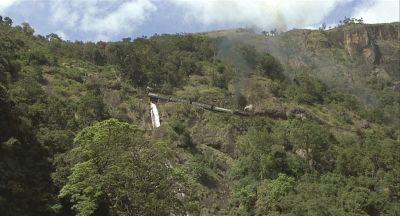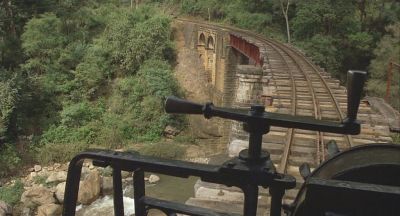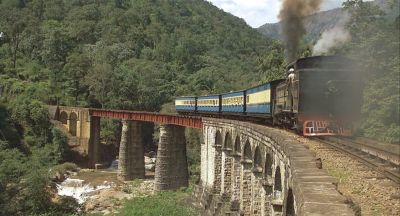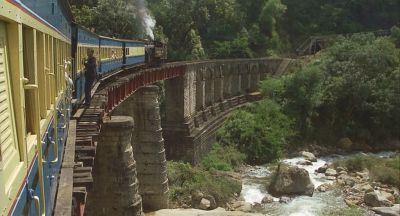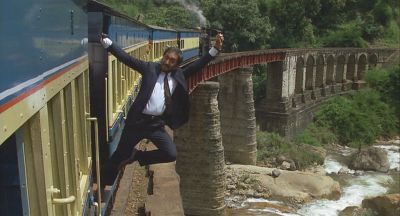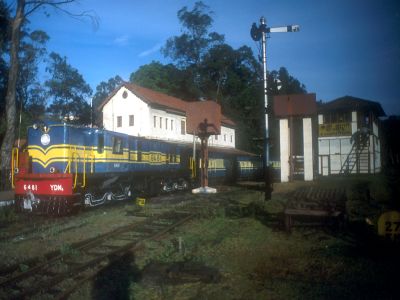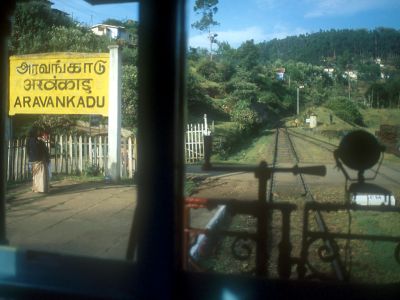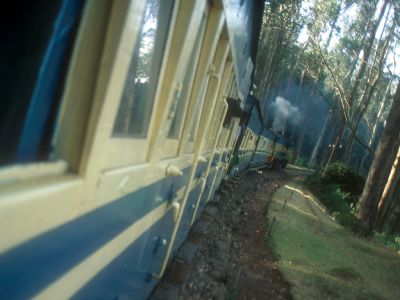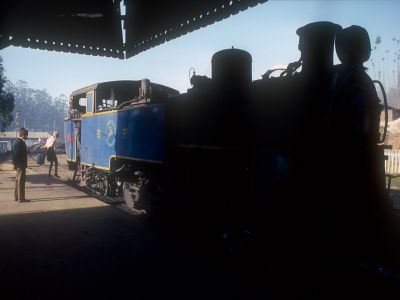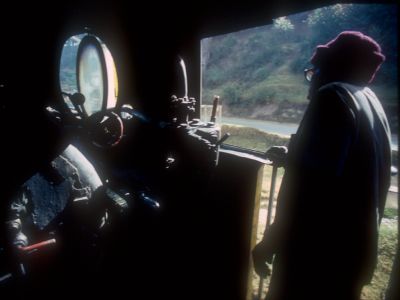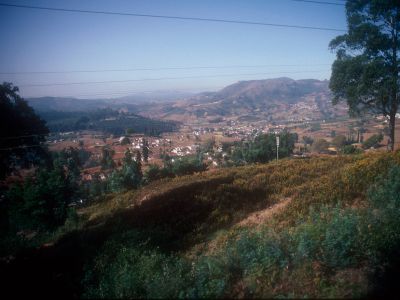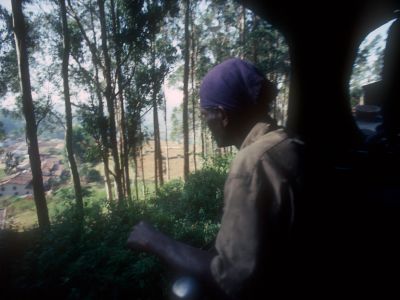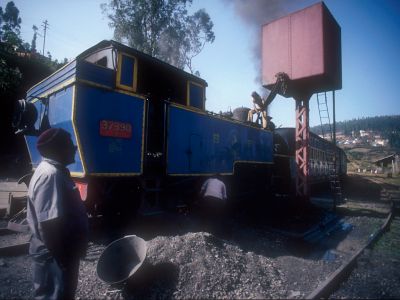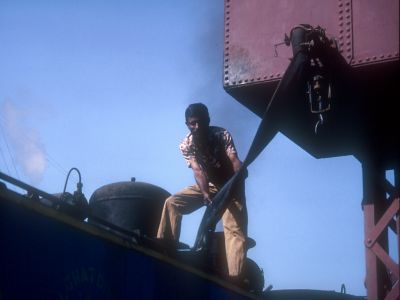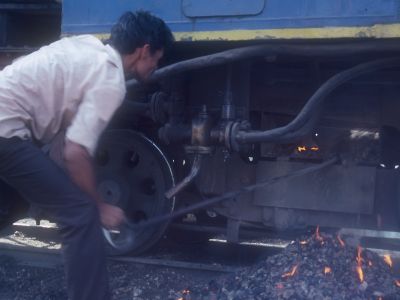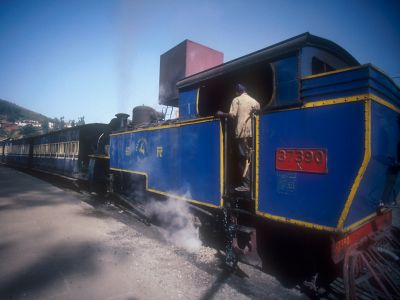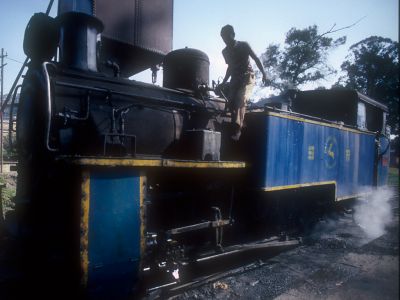Nilgiri Mountain Railway
The Nilgiri Mountain Railway, also know as the Blue Mountain Railway, runs from Mettupalayam on the plains of Tamil Nadu for the 46km via Coonoor to the Hill Station of Udhagamandalam, previously known as Ootacamund or 'Ooty'. It was used by David Lean in the film 'A Passage To India' to take Mrs Moore and Adela Quested on the expedition organised by Dr Aziz to view the Marabar Caves. As detailed on my Coonoor Station page, Coonoor was used as the departure-station of 'Chandrapore', the fictional city where E.M. Forster set his novel. The journey continues into the hills, and Lean uses the stunning locations and scenery of the Nilgiri Mountain Railway to great effect.
We pick up the story after the train has made its departure from Chandrapore. Mrs Moore and Adela have been served breakfast in their cabin, and the darkness of the early-morning departure changes to daylight.
This shot of the waterfall was taken just to the south of Coonoor
This fine view shows the train approaching the Adderley Viaduct, over the Bhawani river, north-west of Kallar. This bridge is 10km from the start of the line, just after Kallar, the first station after Mettupalayam. This still shows quite clearly the central toothed 'rack', fixed between the two metre-gauge railway lines. This rack engages with cogs on the locomotive to enable it to tackle the steep inclines on this route. Further details below. This still also shows the platform at the front of the train, normally occupied by a brake-man who's job it is to apply the front carriage-brake, controlled by the horizontal lever in the centre of the still, in case of accident, emergency, or slippage.
This postcard-perfect shot shows the train, pushed from behind as always, starting to cross the Adderley Viaduct. The locomotive was re-painted for the film.
In the film, we don't see the arrival of the train at the Marabar Hills, so no other station shots from the film are available. The journey of Dr Aziz's party continues by elephant, on my Marabar Caves page.
Some background information: The Nilgiri Mountain Railway (NMR) is a metre gauge railway. First opened on 15th June 1899, it negotiates 16 tunnels and 31 major bridges as it climbs from a height of 326m in Mettupalayam to a height of 2193m at Udhagamandalam. The average gradient is 1 in 12.28 feet, the steepest in Asia. The four and a half hour trip journeys through tea plantations, bamboo thickets, and lush green forest, with spectacular views over mountains and surrounding countryside. The rickety carriages, with their famous blue and cream livery are available in 1st and 2nd classes; the 1st class carriages are at the front of the train and provide the best views. All coaches have a balcony at one end for the brakeman to stand in and operate the rack and wheel brakes. The coaches date from 1931, 1960, and 1964-65. Some of the coaches have been refurbished by the Golden Rock Workshops (GOC) of SR at Tiruchirappali in the late 80's.
Though once all steam-hauled, the section from Coonor to Ooty is now pulled by YDM4 diesel locomotives. It is, however, the steam locos that pull the crowds (in both senses of the word). These coal-fired steam-locomotives come from the Swiss Locomotive Works (SLW) in Winterthur, Switzerland, and provide the traction on the only mountain railway in India with cog-wheel traction. When needed, the cogs or 'pinions' are engaged to a horizontal rack of teeth positioned in the centre of the track. This is only necessary for difficult inclines; these come at various points between Kallar and Coonoor. The locos are 0-8-2 side tanks with 2 sets of cylinders, the low pressure cylinders driving the rack wheels. The first 7 arrived in 1920 and the last 5 in 1952. Though visitors today may be amused at the slow pace (13 kmph on the rack rails) of the train and may even be tempted to trot alongside it, it was a welcome change to the memsahibs of the day when bullock carts averaged four and half to five miles an hour and horses only five to six.
The NMR was recently granted 'World Heritage Status' by the United Nations. See extensive information, photos, and a route map on the UNESCO .pdf page here. You can see plenty of other photos of the Nilgiri Mountain Railway at the IRFCA Photo Gallery
Stations:
The stations on the line were:
- Mettupalayam (R)
- Kallar
- Adderley
- Hillgrove
- Runneymede
- Kateri Road
- Coonoor (R)
- Wellington (R)
- Aravankadu (R)
- Ketti
- Lovedale (R)
- Fernhill
- Ootacamund (R)
Kallar, Adderley, Runneymede and Kateri road are now closed. Ootacamund has been renamed Udhagamandalam.
The (R) suffix indicates that these stations have retiring rooms available to passengers. One of the best kept secrets of Indian Railways, retiring rooms are sleeping accomodation on the station premises; often on the 1st floor above the main offices. They are only available to bona fide passengers with tickets for one 24 hour period; you can't use them like a hotel. The time you check in will be marked on your ticket; that's the time you must check out again, one day later. They are available on a first-come, first-served basis and are allocated by the Station Superintendent or Station Master. You are supposed to be able to reserve them in advance, by sending a money order to the Station Superintendent. Sometimes a basic room service is available, but there is always food in the Refreshment Rooms. The Regional timetables tell you what is available at each station - usually A/C, Standard and Dormitory. (Western women aren't usually allowed in the dormitories.) Retiring room prices are usually very reasonable, and generally indicate the standard.
Back in 1992, steam locomotives still pulled the train from Ooty to Coonoor, and I was lucky enough to travel the section on the locomotive footplate. This is my account of the trip:
We drove to the railway station at Ooty (Udhagamandalam) after breakfast, from where we were to catch the steam train to Coonoor. It was a lovely morning, with bright sunlight. The train arrived, and whilst I was taking photos of the locomotive, the engine-driver invited me to ride on the footplate!! Though not a 'first-class steam-enthusiast', I still like steam engines a lot, so such an offer was responded in the same way a film-buff might respond if offered a kiss with Marilyn Monroe - I jumped at the chance.
We set off, and I had a great time chatting to the driver, taking photos, and blowing the whistle when prompted. The driver wanted baksheesh of course, but I felt it was well worth a small expenditure for the chance of a lifetime. I passed over a 50 rupee note, which the driver took, passed to the fireman, said thank-you on his behalf, then asked for some baksheesh for himself!! OK, so I am not very good at this baksheesh-stuff, but was quite impressed at being caught like that! I passed on another 100, which seemed to be OK.
The driver told me that he had been working on the railways for 38 years, and working this line for 10, so no doubt had got 'fleecing the tourists' down to a fine art, but I did not mind at all, and was just happy to have the kind of ride on a working steam loco that enthusiasts back in England only dream about. The train halted momentarily just outside Coonoor, so that I could nip back to the carriage before the station staff saw me on the locomotive. The remainder of the journey was made in one of the old first class carriages.
Ten years later, in 2002, (where does all that time go?!) I was back in Coonoor, this time whilst reseaching for Footprint Book's 'South India Handbook'. I stayed in the Tamil Nadu hotel (250rs/night) which is just a short walk up the hill from the railway station. Coonoor is spread out over 2-3km, so finding your way around is difficult, though all in all there is not much of interest here to keep the visitor for more than a day or two. Sims Park, started in the 19th century, is the most interesting, with an excellent range of plants, trees, and shrubs well laid out on a sloping site of great variety. Downtown, if it can be so called, there are a few restaurants, and a colorful bazaar full of activity.
The next two photos came to me via an acquaintance on the 'India Mike' website. He had been travelling through Coonor whilst the film was being made, and took these photos as he passed through.
This image shows one of the NMR locomotives that was repainted for the film, in the colors of the fictional 'Marabar Line'.
This image shows a scaffolding-tower erected near the Coonoor engine sheds, perhaps for some overhead shots that were later discarded on the cutting-room floor.
November 2021: Now you can take a 3-D Tour of the Nilgiri Mountain Railway. (Hint: don't click any buttons - it moves from frame to frame by itself, when loaded).

